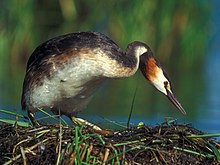奇迹鸟类
奇迹鸟类(学名:Mirandornithes,在2005年,由荷兰鸟类学家桑格斯特所命名[1])这个演化支包括红鹤和鸊鷉,许多学者使用火烈鸟总目(学名:Phoenicopterimorphae)来涵盖红鹤和鸊鷉[2][3]。
| 奇迹鸟类 化石时期:
| |
|---|---|

| |

| |
| 科学分类 | |
| 界: | 动物界 Animalia |
| 门: | 脊索动物门 Chordata |
| 纲: | 鸟纲 Aves |
| 演化支: | 今颚类 Neognathae |
| 演化支: | 新鸟类 Neoaves |
| 演化支: | 雀类 Passerea |
| 演化支: | 水滨鸟类 Aequorlitornithes |
| 演化支: | 奇迹鸟类 Mirandornithes Sangster, 2005 |
| 目 | |
但是要确定这两群的关系却有许多疑难的地方。红鹤曾被放置在今颚下纲内的各种分支里,例如:鸭类和鹳形目;鸊鷉则曾被分类到潜鸟目。无论如何,近代的研究已经碓认它们是姐妹群[3][4][5][6][7][8][9] 。
原始的火烈鸟和鸊鷉都是高度依赖水域生存的鸟类,这种生活习性显示所有的奇迹鸟类都是由水生祖先演化而来[6]。
下面的分支图整理自2015年Prum et al.的论文[10],显示奇迹鸟类的分类地位。
| 水滨鸟类 Aequorlitornithes |
| ||||||||||||||||||
共源性状
编辑依据麦尔(2004)[6]和桑格斯特(2005)[1]的研究,这个演化支拥有至少12种独特的形态共源性状:
1. 至少从第4至第7颈椎是特别拉长的,结合脊凸,形成明显的脊棱;
2. 位于头侧前髆肱肌插入边的肱骨带有明显的卵形凹陷;
3. 至少有23节荐前椎;
4. 至少有4节胸椎愈合成综荐骨;
5. 尺骨远端拥有明显的卵形凹陷骨;
6. 近端指骨在轴向强烈延长且狭窄;
7. 胫跗骨的内侧骨果有明显的缺刻;
8. 胫骨后肌缺乏髋臼:
9. 尾股肌缺乏尾侧部;
10. 有12根初级飞羽;
11. 左颈动脉缩减或缺无;
12. 蛋壳被覆一层垩白色不定形的磷酸钙。
参考文献
编辑- ^ 1.0 1.1 Sangster, G. A name for the flamingo-grebe clade. Ibis. July 2005, 147 (3): 612–615. doi:10.1111/j.1474-919x.2005.00432.x.
- ^ Joel Cracraft; et al. Justifications of names for higher taxa (PDF). [2020-04-24]. (原始内容存档 (PDF)于2016-10-07).
- ^ 3.0 3.1 Jarvis, E.D.; et al. Whole-genome analyses resolve early branches in the tree of life of modern birds. Science. 12 December 2014, 346 (6215): 1320–1331. PMC 4405904 . PMID 25504713. doi:10.1126/science.1253451.
- ^ Tuinen, Van; Butvill, M.; Kirsch, D.B.; Hedges, S.B. Convergence and divergence in the evolution of aquatic birds. Proc. R. Soc. B. 7 July 2001, 268 (1474): 1345–1350. PMC 1088747 . PMID 11429133. doi:10.1098/rspb.2001.1679.
- ^ Chubb, A.L. New nuclear evidence for the oldest divergence among neognath birds: The phylogenetic utility of ZENK (i). Molecular Phylogenetics and Evolution. January 2004, 30 (1): 140–151. PMID 15022765. doi:10.1016/S1055-7903(03)00159-3.
- ^ 6.0 6.1 6.2 Mayr, G. Morphological evidence for sister group relationship between flamingos (Aves: Phoenicopteridae) and grebes (Podicipedidae). Zoological Journal of the Linnean Society. February 2004, 140 (2): 157–169. doi:10.1111/j.1096-3642.2003.00094.x.
- ^ Fain, M.G. Houde. Parallel radiations in the primary clades of birds. Evolution. November 2004, 58 (11): 2558–2573. PMID 15612298. doi:10.1554/04-235.
- ^ Ericson, J.I.; Anderson, P.G.P.; Britton, C.L.; Elzanowski, T.; Johansson, A.; Kllersj, U.S.; Ohlson, M.; Parsons, T.J. Diversification of Neoaves: integration of molecular sequence data and fossils. Biology Letters. 22 December 2006, 2 (4): 543–547. PMC 1834003 . PMID 17148284. doi:10.1098/rsbl.2006.0523.
- ^ Hackett, S.J.; et al. A phylogenomic study of birds reveals their evolutionary history. Science. 27 June 2008, 320 (5884): 1763–1768. PMID 18583609. doi:10.1126/science.1157704.
- ^ Prum, R.O. et al. (2015) A comprehensive phylogeny of birds (Aves) using targeted next-generation DNA sequencing (页面存档备份,存于互联网档案馆). Nature 526, 569–573.